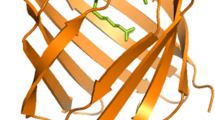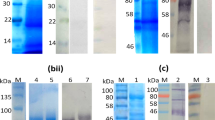Abstract
Parasitic nematodes have recently been found to produce proteins which represent two new classes of fatty acid and retinoid binding protein. The first is the nematode polyprotein allergens/antigens (NPAs) which, as their name suggests, are synthesised as large polyproteins which are subsequently cleaved at regularly spaced sites to form multiple copies of a fatty acid binding protein of approximately 14.5 kDa. Binding studies using molecular environment-sensitive fluorescent ligands have shown that the binding site is highly unusual, producing blue-shifting in fluorescence to an unprecedented degree, suggesting a remarkably non-polar environment and isolation from solvent water. Computer-based structural predictions and biophysical observations have identified the NPAs as highly helical proteins which might form a four helix bundle, so constitute a new class of lipid binding protein from animals. The second class, like the NPAs, binds both fatty acids and retinol, but with a higher affinity for the latter. These are also highly helical but are structurally distinct from the NPAs. The biological function of these new classes of protein are discussed in the context of both the metabolic requirements of the parasites and the possible role of the proteins in control of the immune and inflammatory environment of the tissue sites parasitised.
Similar content being viewed by others
References
Sacchettini JC, Gordon JI: Rat intestinal fatty acid binding protein. A model system for analyzing the forces that can bind fatty acids to proteins. J Biol Chem 268: 118399–18402, 1993
Haunerland NH, Jacobsen BL, Wesenberg G, Rayment I, Hoiden HM: Three-dimensional structure of the muscle fatty-acid-binding protein isolated from the Desert Locust Schistocerca gregaria. Biochemistry 33: 12378–12385, 1994
Becker MM, Kalinna BH, Waine GJ, McManus DP: Gene cloning, over-production and purification of a functionally active fatty acid-binding protein (Sj-FABPc) from the human blood fluke Schistosoma japonicum. Gene 148: 321–325, 1994
Mei B, Kennedy MW, Beauchamp J, Komuniecki PR, Komuniecki R: Secretion of a novel, developmentally regulated fatty acid binding protein into the perivitelline fluid of the parasitic nematode, Ascaris suum. J Biol Chem 272: 9933–9941, 1997
Gomar J, Petit M-C, Sodano P, Sy D, Marion D, Kader J-C, Vovelle F, Ptak M: Solution structure and lipid binding of a nonspecific lipid transfer protein extracted from maize seeds. Protein Science 5: 565–577, 1996
Kennedy MW, Qureshi F: Stage-specific secreted antigens of the parasitic larval stages of the nematode Ascaris. Immunology 58: 515–522, 1986
Christie JF, Dunbar B, Davidson I, Kennedy MW: N-terminal amino acid sequence identity between a major allergen of Ascaris lumbricoides and Ascaris suum, and MHC-restricted IgE responses to it. Immunology 69: 596–602, 1990
McGibbon AM, Christie JIF, Kennedy MW, Lee TDG: Identification of the major Ascaris allergen and its purification to homogeneity by high-performance liquid chromatography. Mol Biochem Parasitol 39: 163–172, 1990
Tomlinson LA, Christie JF, Fraser EM, McLaughlin D, McIntosh AE, Kennedy MW: MHC restriction of the antibody repertoire to secretory antigens, and a major allergen, of the nematode parasite Ascaris. J Immunol 143: 2349–2356, 1989
Christie JF, Fraser EM, Kennedy MW: Comparison between the MHC-restricted antibody repertoires to Ascaris antigens elicited by adjuvant-assisted immunisation or infection. Parasite Immunol 14: 59–73, 1992
Wilkinson TCI, Wilton DC: Studies on fatty acid-binding proteins. The detection and quantification of the protein from rat liver using a fluorescent fatty acid analogue. Biochem. J 238: 419–424, 1986
Thumser AEA, Evans C, Worrall AF, Wilton DC: Effect on ligand binding of arginine mutations in recombinant rat liver fatty acid-binding protein. Biochem J 297: 103–107, 1994
Macgregor RB, Weber G: Estimation of the polarity of the protein interior by optical spectroscopy. Nature 319: 70–73, 1986
Kennedy MW, Brass A, McCruden AB, Price NC, Kelly SM, Cooper A: The ABA-1 allergen of the parasitic nematode Ascaris suum: Fatty acid and retinoid binding function and structural characterization. Biochemistry 34: 6700–6710, 1995
Nesheim MC: Ascariasis and human nutrition. In: D.W.T. Crompton, M.C. Nesheim, Z.S. Pawlowski (eds). Ascariasis and its Prevention and Control. Taylor & Francis, London, 1989, pp 87–107
Sani BP, Vaid A: Specific interaction of ivermectin with retinol-binding protein from filarial parasites. Biochem J 249: 929–932, 1988
Sani BP, Vaid A, Comley JCW, Montgomery JA: Novel retinoid-binding proteins from filarial parasites. Biochem J 232: 577–583, 1985
Tweedie S, Paxton WA, Ingram L, Maizels RM, McReynolds LA, Selkirk ME: Brugia pahangi and Brugia malayi - a surface-associated glycoprotein (gp15/400) is composed of multiple tandemly repeated units and processed from a 400–kda precursor. Exp Parasitol 76: 156–164, 1993
Paxton WA, Yazdanbakhsh M, Kurniawan A, Partono F, Maizels RM, Selkirk ME: Primary structure and IgE response to the repeat subunit of gp15/400 from human lymphatic filarial parasites. Infec Immun 61: 2827–2833, 1993
Spence HJ, Moore J, Brass A, Kennedy MW: A cDNA encoding repeating units of the ABA-1 allergen of Ascaris. Mol Biochem Parasitol 57: 339–344, 1993
Culpepper J, Grieve RB, Friedman L, Mika-Grieve M, Frank GR, Dale B: Molecular characterization of a Dirofilaria immitis cDNA encoding a highly immunoreactive antigen. Mol Biochem Parasitol 54: 51–62, 1992
Poole CB, Grandea AG, Maina CV, Jenkins RE, Selkirk ME, McReynolds LA: Cloning of a cuticular antigen that contains multiple tandem repeats from the filarial parasite Dirofilaria immitis. Proc Nat Acad Sci (USA) 89: 5986–5990, 1992
Britton C, Moore C, Gilleard JS, Kennedy MW: Extensive diversity in repeat unit sequences of the cDNA encoding the polyprotein antigen/allergen from the bovine lungworm Dictyocaulus viviparus. Mol Biochem Parasitol 72: 77–88, 1995
Barr PJ: Mammalian subtilisins: The long-sought dibasic processing endoproteases. Cell 66: 1–3, 1991
Rothnagel JA, Steinert PM: The structure of the gene for the mouse filaggrin and a comparison of the repeating units. J Biol Chem 2165: 1862–1865, 1990
Poole CB, Hornstra LJ, Benner JS, Fink JR, McReynolds LA: Carboxy terminal sequence divergence and processing of the polyprotein antigen from dirofilaria-immitis. Mol Biochem Parasitol 82: 51–65, 1996
Branden C, Tooze J: Protein Structure. Garland Publishing. New York and London, 1991
Kennedy MW, Britton C, Price NC, Kelly SM, Cooper A: The DvA-1 polyprotein of the parasitic nematode Dictyocaulus viviparus: A small helix-rich lipid-binding protein. J Biol Chem 270: 19277–19281, 1995
Kennedy MW, Allen JE, Wright AS, McCruden AB, Cooper A: The gp15/400 polyprotein antigen of Brugia malayi binds fatty acid and retinoids. Mol Biochem Parasitol 71: 41–50, 1995
Steif C, Weber P, Hinz H-J, Flossdorf J, Cesareni G, Kokkinidis M: Subunit interactions provide a significant contribution to the stability of the dimeric 4–alpha-helical-bundle protein ROP. Biochemistry 32: 3867–3876, 1993
He XM, Carter DC: Atomic structure of human serum albumin. Nature 358: 209–215, 1992
Frapin D, Dufour E, Haertle T: Probing the fatty acid binding site of beta-lactoglobulins. J Prot Chem 12: 443–449, 1993
Varley PG: Fluorescence spectroscopy. Meth Mol Biol 22: 203–218, 1994
Kennedy MW, Garside LH, Goodrick LE. McDermott L, Brass A, Price NC, Kelly SM, Cooper A, Bradley JE: The Ov20 protein of the parasitic nematode Onchocerca volvulus. A structurally novel class of small helix-rich retinol-binding protein. J Biol Chem 272: 29442–29448, 1997
Tree TIM, Gillespie AJ, Shepley KJ, Blaxter ML, Tuan RS, Bradley JE: Characterisation of an immunodominant glycoprotein antigen of Onchocerca volvulus with homologues in other filarial nematodes and Caenorhabditis elegans. Mol Biochem Parasitol 69: 185–195, 1995
Kragelund BB, Andersen KV, Madsen JC, Knudsen J, Poulsen FM: 3–Dimensional structure of the complex between acyl coenzyme A binding-protein and palmitoyl coenzyme A. J Mol Biol 230: 1260–1277, 1993
Barrett J: Biochemistry of Parasitic Helminths. University Park Press, Baltimore, 1981
Murphy RC, Fitzpatrick FA (eds).: Arachidonate Related Lipid Mediators. Meth Enzymol 187. Academic Press Inc., San Diego, New York, London, 1990
Gerrard JM: Prostaglandins and Leukotrienes: Blood and Vascular Cell Function. Marcel Dekker Inc., New York and Basel, 1985
Leid M. Kastner P, Chambon P: Multiplicity generates diversity in the retinoic acid signalling pathways. Trends Biochem Res 17: 427–433, 1992
Carman JA, Pond L. Nashold F, Wassom DL, Hayes CE: Immunity to Trichinella spiralis infection in vitamin-A deficient mice. J Exp Med 175: 111–120, 1992
Author information
Authors and Affiliations
Rights and permissions
About this article
Cite this article
McDermott, L., Cooper, A. & Kennedy, M.W. Novel classes of fatty acid and retinol binding protein from nematodes. Mol Cell Biochem 192, 69–75 (1999). https://doi.org/10.1023/A:1006822321081
Issue Date:
DOI: https://doi.org/10.1023/A:1006822321081




